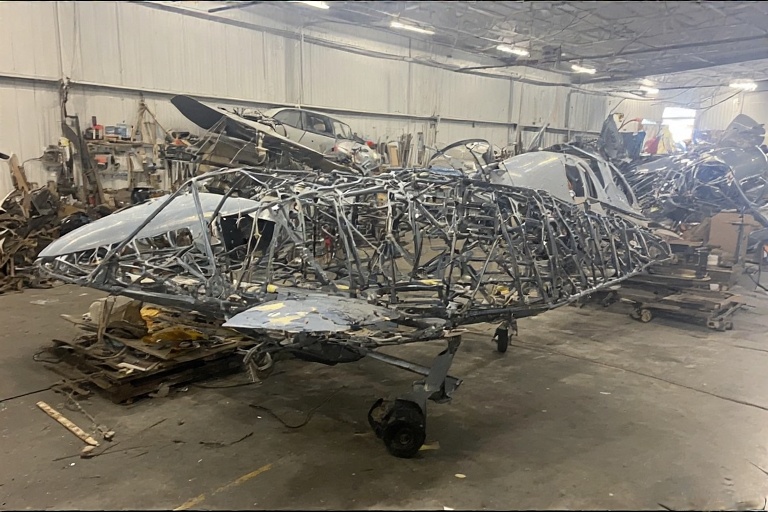
The 1990 Zenith 701 aircraft partially assembled is a fascinating topic for aviation enthusiasts and homebuilders alike. Introduced in 1986 by Zenith Aircraft Company, the STOL CH 701 is a short takeoff and landing (STOL) kit plane designed for rugged, off-airport adventures. By 1990, this aircraft had gained popularity among sport pilots for its simple construction and remarkable performance. A partially assembled Zenith 701 from this era represents a unique opportunity to dive into the world of amateur-built aircraft, offering hands-on experience in aviation engineering. Whether you’re a student dreaming of flight or a builder seeking a rewarding project, the 1990 Zenith 701 aircraft partially assembled sparks curiosity and creativity. This article explores its history, design, assembly process, and the thrill of completing such a project, all while keeping the focus on this iconic aircraft.
The History of the Zenith STOL CH 701
The Zenith STOL CH 701, first flown in 1986, was designed by Canadian aeronautical engineer Chris Heintz through his company, Zenair. By 1990, the 1990 Zenith 701 aircraft partially assembled was a common sight among homebuilders due to its affordability and ease of construction. The aircraft was created to meet the needs of sport pilots who wanted a versatile plane capable of operating in challenging environments, like grassy fields or remote airstrips. Its high-lift wing, full-span leading-edge slats, and all-flying rudder made it a standout for STOL performance. The 1990 Zenith 701 aircraft partially assembled often came with detailed blueprints and manuals, making it accessible for first-time builders. Zenith’s move to Mexico, Missouri, in 1992 further boosted production, ensuring support for builders tackling a 1990 Zenith 701 aircraft partially assembled.
Design Features of the 1990 Zenith 701
The 1990 Zenith 701 aircraft partially assembled is known for its rugged, all-metal construction, designed for simplicity and durability. Its high-wing design, coupled with fixed leading-edge slats, allows for exceptional lift, enabling takeoffs in less than 120 feet on grass. The aircraft’s flaperons—a combination of flaps and ailerons—provide precise control, while the all-flying rudder enhances maneuverability. Typically powered by Rotax engines like the 64-hp 582 or the 80-hp 912UL, the 1990 Zenith 701 aircraft partially assembled offered a gross weight of around 960 to 1100 pounds. Builders working on a 1990 Zenith 701 aircraft partially assembled appreciated its pre-drilled components and straightforward assembly, requiring only basic tools like drills and rivet guns. This design made it a favorite for those new to aircraft construction.
Why Choose a Partially Assembled Zenith 701?
A 1990 Zenith 701 aircraft partially assembled offers a unique blend of challenge and reward. For students or hobbyists, it’s a hands-on way to learn about aerodynamics and engineering. Unlike a fully built plane, a 1990 Zenith 701 aircraft partially assembled lets builders customize components, such as engine choices or avionics, to suit their needs. The partially completed state often includes assembled sections like the rudder or wings, reducing the workload while still requiring skill to finish. This makes it ideal for those with limited time or experience. Additionally, Zenith’s ongoing support, including workshops and online resources, ensures builders of a 1990 Zenith 701 aircraft partially assembled have guidance. The aircraft’s affordability compared to factory-built planes also makes it an attractive option for budget-conscious aviation enthusiasts.
The Assembly Process
Completing a 1990 Zenith 701 aircraft partially assembled is a rewarding journey. The process starts with organizing the kit’s pre-cut and pre-drilled parts, such as wing spars and fuselage skins. Builders follow detailed CAD blueprints and photo assembly guides provided by Zenith. For a 1990 Zenith 701 aircraft partially assembled, some components, like the tail section or wings, may already be riveted, saving time. The builder then focuses on assembling the fuselage, installing the landing gear, and mounting the engine. Basic tools like aviation shears and electric drills are sufficient, and no complex jigs are needed. Zenith’s step-by-step manuals make the process approachable, even for beginners. Completing a 1990 Zenith 701 aircraft partially assembled typically takes 400 to 600 hours, depending on the builder’s skill and the kit’s completion level.
Challenges of Working on a Partially Assembled Kit
Building a 1990 Zenith 701 aircraft partially assembled comes with challenges. One major hurdle is verifying the quality of prior work. If the previous builder made errors, such as misaligned rivets or incorrect measurements, it can delay progress. Builders must inspect every component to ensure it meets Zenith’s standards and FAA regulations for experimental aircraft. Another challenge is sourcing missing parts, as some components for a 1990 Zenith 701 aircraft partially assembled may no longer be in production. Builders may need to contact Zenith or other suppliers for replacements. Additionally, integrating modern avionics or engines into a 1990 Zenith 701 aircraft partially assembled requires technical knowledge, as the original design may not accommodate newer technology without modifications. Despite these challenges, the process teaches problem-solving and patience.
Benefits of Completing a Zenith 701
Finishing a 1990 Zenith 701 aircraft partially assembled offers numerous benefits. First, it’s a cost-effective way to own a plane, with kits often priced significantly lower than factory-built aircraft. The sense of accomplishment from flying an aircraft you built is unmatched, boosting confidence and pride. The 1990 Zenith 701 aircraft partially assembled also allows for customization, letting builders tailor the plane to their preferences, such as adding larger fuel tanks or upgraded instruments. Its STOL capabilities make it ideal for adventurous pilots who want to land on remote strips or farms. Moreover, the skills learned—riveting, reading blueprints, and understanding aerodynamics—are valuable for future projects. For students, working on a 1990 Zenith 701 aircraft partially assembled can spark a lifelong passion for aviation and engineering.
Legal and Regulatory Considerations
A 1990 Zenith 701 aircraft partially assembled falls under the FAA’s “Experimental” or “Amateur-Built” category, meaning it’s treated as a one-of-a-kind aircraft. Builders must comply with strict regulations to ensure airworthiness. This includes maintaining a detailed builder’s log, documenting every step, and having the aircraft inspected by an FAA representative or designated airworthiness representative. The 1990 Zenith 701 aircraft partially assembled must meet weight and balance requirements, with forms like the 701 W&B report used to verify the center of gravity. Builders should also transfer the kit’s serial number to their name with Zenith and secure a bill of sale. While the process is rigorous, it ensures the 1990 Zenith 701 aircraft partially assembled is safe for flight, protecting both the pilot and the public.
Community and Support for Builders
Zenith Aircraft Company provides extensive support for those working on a 1990 Zenith 701 aircraft partially assembled. Their factory in Mexico, Missouri, offers workshops where builders can gain hands-on experience. Online resources, like the ZENITH.AERO community, connect builders worldwide, offering tips and troubleshooting advice. For a 1990 Zenith 701 aircraft partially assembled, Zenith’s technical support team is just a call or email away, helping with everything from part identification to assembly techniques. Local builders’ groups, like the STOL Bandits in Tennessee, also provide camaraderie and knowledge-sharing. This support network makes completing a 1990 Zenith 701 aircraft partially assembled less daunting, fostering a sense of community among aviation enthusiasts and ensuring no builder feels alone in their project.
The Thrill of Flying a Zenith 701
Once completed, a 1990 Zenith 701 aircraft partially assembled becomes a ticket to adventure. Its STOL capabilities allow pilots to take off and land in incredibly short distances—under 120 feet on grass—making it perfect for backcountry flying. Pilots like Jon Humberd, who flies his Zenith 701 over his Tennessee farm, praise its agility and reliability. The aircraft’s side-by-side seating and simple controls make it user-friendly, while its durable all-metal construction handles rough terrain with ease. For those who finish a 1990 Zenith 701 aircraft partially assembled, the first flight is a milestone, combining the thrill of aviation with the pride of craftsmanship. Whether buzzing over fields or landing on remote strips, the Zenith 701 delivers an unmatched flying experience.
Modern Relevance of the 1990 Zenith 701
Even today, the 1990 Zenith 701 aircraft partially assembled remains relevant. While newer models like the CH 750 have upgraded features, the CH 701’s simplicity and affordability keep it popular. Its design has inspired countless homebuilders, with over 1000 CH 701s flying worldwide. For students or hobbyists interested in aviation, a 1990 Zenith 701 aircraft partially assembled offers a tangible connection to the history of kit planes. Its legacy as a pioneer in the Light Sport Aircraft category, combined with Zenith’s ongoing support, ensures it remains a viable project. Completing a 1990 Zenith 701 aircraft partially assembled not only builds an airplane but also preserves a piece of aviation history, making it a timeless endeavor for enthusiasts.
FAQs
What is a 1990 Zenith 701 aircraft partially assembled?
A 1990 Zenith 701 aircraft partially assembled is a kit plane from Zenith Aircraft Company, with some components, like the wings or tail, already built. It requires further assembly to become airworthy, offering builders a head start on construction.
How long does it take to complete a 1990 Zenith 701 aircraft partially assembled?
Completion time varies, but a 1990 Zenith 701 aircraft partially assembled typically takes 400 to 600 hours, depending on the builder’s experience and the extent of pre-assembly. Detailed manuals and support reduce the learning curve.
What skills are needed to finish a 1990 Zenith 701 aircraft partially assembled?
Basic mechanical skills, such as drilling, riveting, and reading blueprints, are sufficient. No advanced tools or engineering degrees are required, making the 1990 Zenith 701 aircraft partially assembled accessible to beginners with Zenith’s guidance.
Are parts for a 1990 Zenith 701 aircraft partially assembled still available?
Yes, Zenith Aircraft Company still supports the CH 701, offering replacement parts and technical assistance. Builders may also source parts from other suppliers or the ZENITH.AERO community for a 1990 Zenith 701 aircraft partially assembled.
Is it safe to fly a 1990 Zenith 701 aircraft partially assembled once completed?
If built according to Zenith’s instructions and FAA regulations, a completed 1990 Zenith 701 aircraft partially assembled is safe for flight. Proper inspections and adherence to weight and balance guidelines are critical for airworthiness.
Conclusion
The 1990 Zenith 701 aircraft partially assembled is more than just a kit plane; it’s a gateway to adventure, learning, and personal achievement. Completing this iconic aircraft offers students and hobbyists a chance to master hands-on skills like riveting and blueprint reading while crafting a machine capable of thrilling STOL performance. Despite challenges like verifying prior work or sourcing parts, the support from Zenith Aircraft Company and its vibrant community makes the journey achievable. Finishing a 1990 Zenith 701 aircraft partially assembled not only results in a rugged, versatile plane but also instills a deep sense of pride and connection to aviation history. For those passionate about flight, this project remains a timeless and rewarding endeavor, blending creativity, engineering, and the joy of soaring into the skies.


